The cooler weather is approaching, and the leaves are slowly changing. Now that summer is over, it’s time to think about what to do for your landscape to keep it healthy during the harsh winter months.
You may think, “Do I really need to care for my lawn in the fall?” The answer is yes.
There are many things to do in the fall to prepare your lawn for the winter. Preparation now will provide you with an even more beautiful landscape come next spring.
In this blog we discuss important fall tips for a beautiful lawn and landscape.
What Happens to Your Lawn in the Fall?
To understand how to keep your landscape looking its best, first it’s important to know how it changes during fall.
As the vibrant colors of summer begin to fade and temperatures start to drop, your lawn undergoes significant changes to prepare for the colder months ahead. Understanding these changes is key to keeping your landscape looking its best year-round. Let’s explore what happens to your lawn during the fall and why this season is critical for your grass’s health.
Grass Growth Slows but Roots Thrive
In the fall, your lawn’s growth above ground slows down as the temperatures drop. While the grass blades may not grow as vigorously as they did during spring and summer, important changes are happening below the surface. Fall is the ideal time for grass to develop and strengthen its root system, which is essential for surviving the winter and thriving in the following spring.
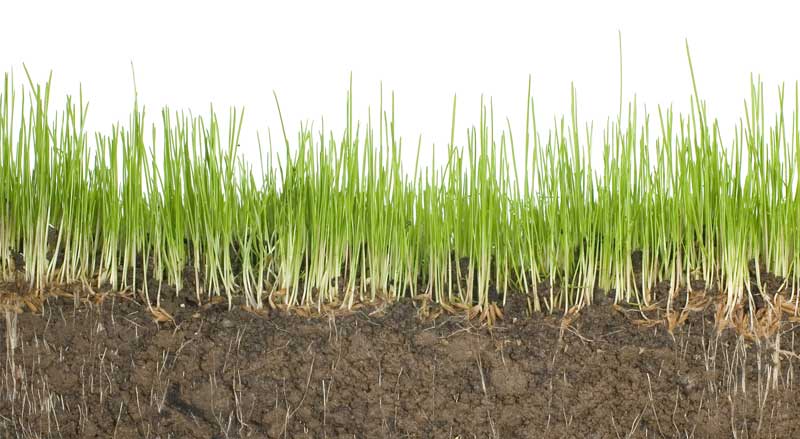
Cooler Temperatures Support Root Development
As the weather cools, soil remains warm enough to promote root growth without the stress of summer heat. These conditions make fall the perfect season to focus on root health. By encouraging strong, deep roots during the fall, your lawn will be better equipped to handle cold winter temperatures and come back stronger when spring arrives.
Nutrient Storage and Energy Accumulation
During the fall, your lawn also enters a phase of storing nutrients. The grass absorbs essential nutrients from the soil, using them to strengthen the roots and prepare for dormancy. This nutrient storage ensures that your grass has the energy it needs to survive the winter months when growth above ground comes to a halt.
Fall Lawn Care Best Practices
The following topics will take the guessing out of fall landscaping practices that benefit the growth and vibrancy of your property.
1. Take A Walk
Walk around your landscape and inspect how each area of your yard has progressed throughout the past year. Take notice of plants or tress that may have disease, overgrowth, or are dead.
Make a note of spaces in your landscape where plants have flourished and places they have not so that you can find the correct type of plant for that area.
2. Continue to Mow Your Lawn
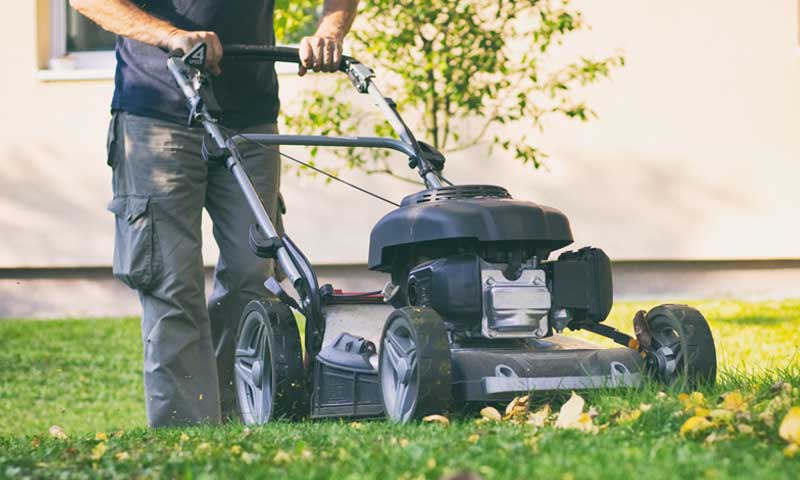
Continue mowing your lawn for a bit longer—at least until it stops growing. And even, perhaps, until the first frost arrives.
For the last cut of the season, take your turf down to 1¼ inches. Less leaves will get caught in your lawn if it is shorter and disease will have a difficult time latching on. Grass receives most of its nutrients from the upper parts of its blade; cutting your lawn shorter than the recommended height may result in its inability to grow.
If you are reseeding, mow new seed when it reaches a height that is one-third higher than its normal growing height. Don’t cut the new grass too short; this can hurt the root system.
3. Rake Often and Dethatch
Fallen leaves are beautiful. Kids and pets love to frolic in them. Unfortunately, these leaves can hurt your lawn—and family. They can harbor disease-carrying ticks and other garden pests. More reason to remove them.
A wet leaf covering on your landscape can also promote fungi.
Pest and fungi concern aside, leaves on your lawn block out much needed sunlight. This keeps the lawn from getting all the sunlight it needs to remain healthy.
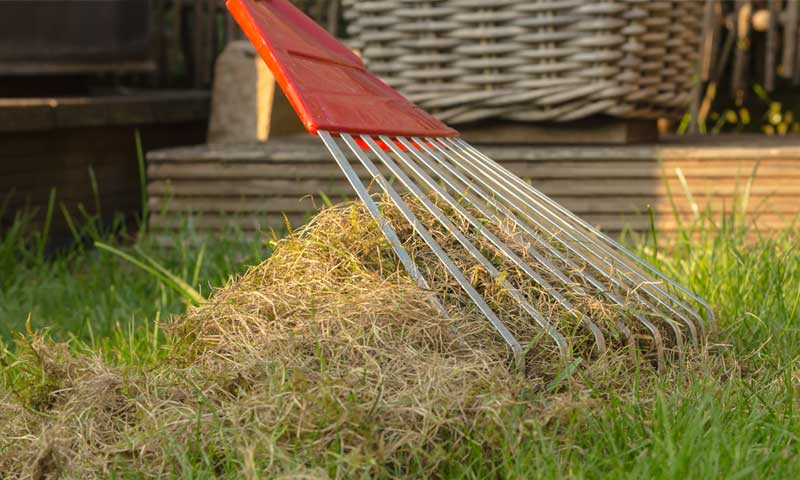
Even if you have a leaf blower, you may get better results by manually raking soggy leaf and thatch buildup. Raking stimulates the area.
Rake on a weekly basis to prevent leaves from accumulating on your property. But most importantly, do not let leaves remain on your lawn over the winter.
Pro-Tip
Save the leaves collected from your gutters and lawn to create a compost bin in your yard. There are a variety of materials that can be used to contain your compost, but something as simple as chicken wire will do the trick.
Transport leaves to your compost pile via a large plastic tarp to make the job a little easier. Flip the leaves in your compost weekly to ensure that they will be ready to “feed” next year’s beds and lawn.
4. Aerate for a Healthy Lawn
Throughout the summer months, soil compresses and lawns suffer from heat stress—leaving brown patches and bare spots.
Even the most vigilant watering program may not have been enough to protect your lawn from the sun. When you aerate in the fall, you are helping the grass be healthier in the spring. The best aeration occurs in the cooler months when the soil is moist—but not too wet.
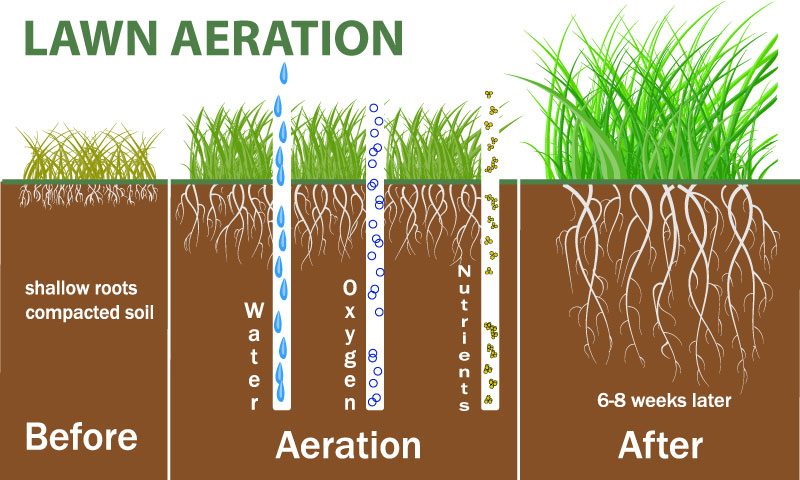
Aerating your lawn is a good practice to follow for anyone trying to maintain a healthy landscape but especially for homeowners who have rainfall pools on their grass, high traffic areas or a lot of shade.
The technique of aerating allows water, air and nutrients to reach the roots of your lawn by pulling out plugs of compressed soil. You can utilize a garden fork for smaller areas but for larger sections a walk-behind aerator is more efficient.
5. Reseed Your Lawn in the Fall
Usually by the end of the summer, your lawn isn’t looking as lush as it did a few months ago.
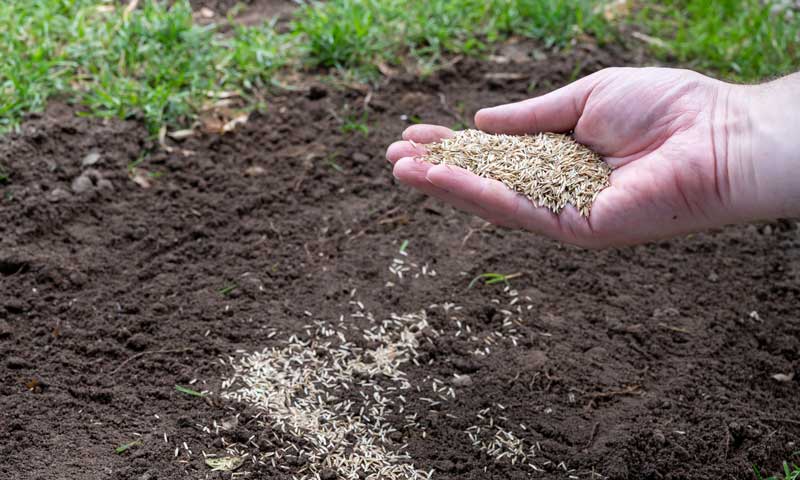
There are probably areas of bare spots and dead grass. If the summer was harsh, it might even be in a lot worse shape.
Reseed these damaged areas in the fall after the lawn is aerated and dethatched. Using high-quality seed will make a big difference.
Mid-August to mid-September is the optimal time to seed, so that the new grass can establish roots before being killed by the winter weather. However, dormant seeding can be done even later, sowing grass seeds that will sprout and grow in the spring.
A lawn spreader works well to seed larger areas; use a hand spreader for smaller ones. Tamp down the areas of new seeding to help the seed stay in place for germination. For these seeds to germinate, they will need to touch the soil. You can cover newly seeded areas with straw or leaf compost.
6. The Fall is a Good Time to Fertilize
The fall is by far the best time to fertilize your lawn.
Fertilize with a product that will help keep your fall lawn healthy, given your location and climate conditions. Fertilizer provides nutrients that your lawn will need to survive the winter and grow come the spring.
A great time to fertilize is after you aerate your lawn and reseed. The aeration will make sure that the nutrients from the fertilizer can go deep into the soil.
Grass roots grow until the temperatures dip below 40 degrees. Fall fertilizing helps develop strong, healthy roots for vibrant spring growth. Use a high-phosphorous mix on your grass before the weather gets too cold.
At Sponzilli Landscape Group, we have been moving toward the elimination of pesticides and synthetic fertilizers on NJ and NYC lawns. We don’t use harsh chemical products and instead create healthy lawns naturally.
7. Don’t Forget to Water
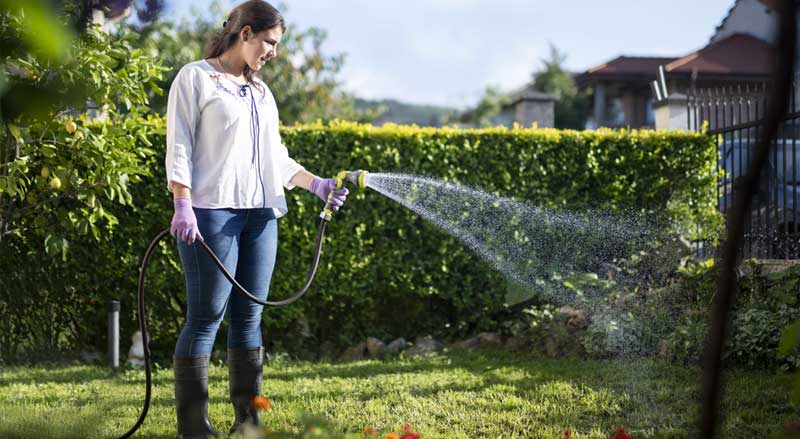
Your lawn will still need water in the fall—just not as much as in the spring and summer when heat makes water evaporate quickly. The cooler fall days mean there’s less evaporation.
If you have just reseeded, keep the seed moist until it germinates. Water when necessary.
Afterward, fall rainfall may offer enough water for your lawn. Pay attention to how much rain your lawn is getting. Ideally, your lawn gets an inch or more of water each week. If your lawn isn’t receiving this, water it. Some people use a rain gauge to remove the guesswork.
Watering also helps fertilizer dissolve and soak into the ground. This will strengthen growth for the coming year and provide nutrients for colorful autumn flowers.
8. Check for Grubs and Other Lawn Pests
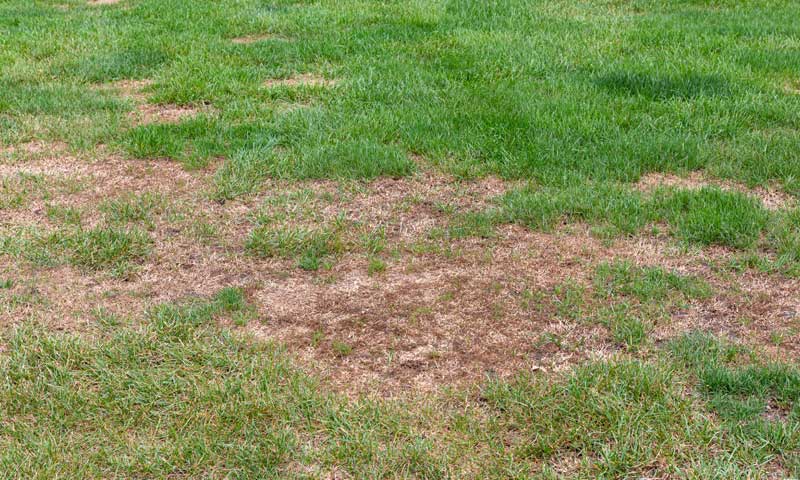
Your lawn may have uninvited and unwanted pests. Sometimes it’s easy to see the damage they caused.
A grub infestation will cause areas of thinning grass. These pests will enjoy their winter stay and cause more damage once your lawn renews in the spring.
The fall is the best time to take care of lawn pests—before they do damage.
Common lawn pests in New Jersey include:
- Grubs
- Armyworms
- Chinch bugs
- Ticks
- Billbugs
9. Remove Dead Branches and Plants
Large, lifeless branches can be dangerous to you and your home, especially during the winter months when snow and wind take over. Trees add value to a property (some real-estate experts say healthy trees increase property values by $15,000) so don’t shy away from quality maintenance.
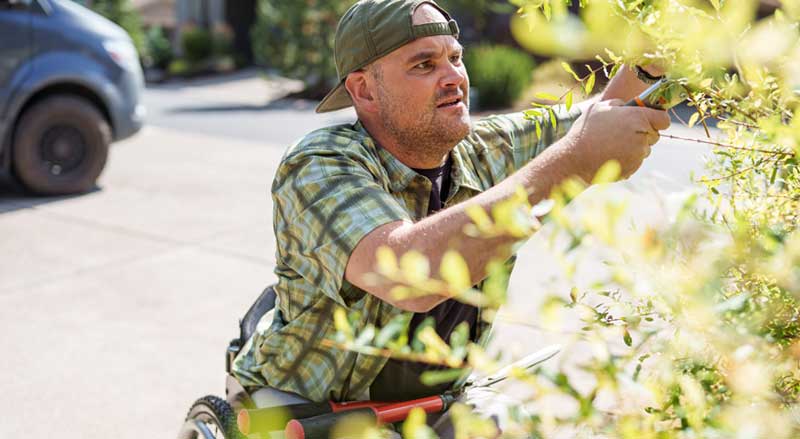
Go ahead and prune out all the dead remnants on plants. This will help provide the proper energy for healthy growth in the spring.
Protect smaller trees from further damage by trimming diseased branches close to (but not flush with) the trunk. For larger trees, call a certified professional to assess the situation.
Keep in mind, there are some trees and shrubs that should not be pruned in the fall because of the potential to remove new growth.
10. Clean Gardens and Beds
The fall is a good time to weed your landscape—within reason.
It’s best to pull out the weeds by hand. Weed control products often interfere with germination of newly planted grass. You can mow larger areas of weeds and simply reseed.
In the spring, you can undertake stronger weed control efforts. The soil is warming, and your new grass isn’t as vulnerable.
Snails and slugs tend to feed on annuals that are left to decompose in gardens. Take time to remove the annuals and snails/slugs from your landscape so that your spring beds will be healthier.
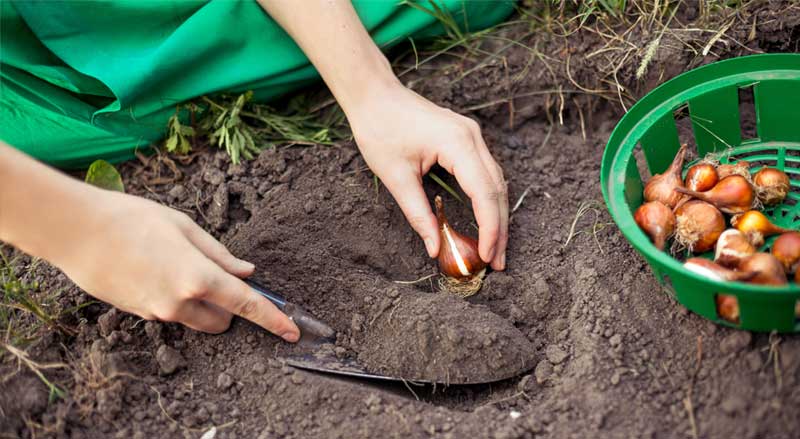
Plant your bulbs and mark them with a small stick so that you don’t disturb them during your spring planting.
Pro-Tip
Every three years, divide crowded plants to make room for more flowers to bloom.
11. Protect Young Plants
If you recently had any new plantings installed, continue to water them every 10 to 14 days until the end of October. The goal is to allow enough time for the roots to be established in the existing soil before winter arrives.
Till decomposed mulch or compost into your soil to give plants fresh and vital nutrients to survive the winter. Then after a light frost, but before the ground freezes, place a 2-4 inch layer of mulch around the plants you have tilled to give them warmth and protection from runoff during the cold weather.
A lack of nutrients can harm plants but so can deer. Deer can be an ongoing problem in your landscape any time of year.
A simple way to protect your plants is to use black plastic netting. Cover plants deer love such as yew, arborvitae, and rhododendrons by ensuring the netting is secured tightly to the ground or a structure.
Deer have also been known to damage the trunks of young trees by rubbing their antlers against them. You can protect the trunks of your trees with plastic tree wrap. Remove wraps in spring to ensure healthy tree growth.
12. Fall Homeowner Hacks
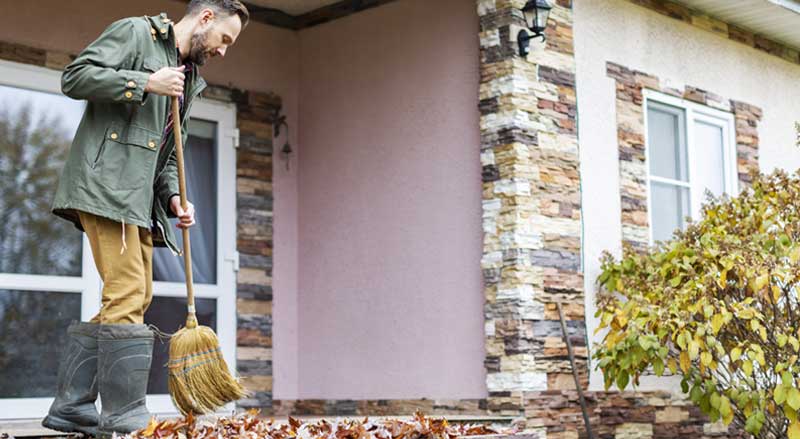
Here are a few other useful tips for your landscape that will put you ahead come springtime.
- Clean Your Exterior: Power wash the exterior of your home and hardscape surfaces before salt or other chemicals trap stains into them. Power washing will also enable you to look over surfaces (driveway, patios, etc.) and make sure they are not in need of repair before the ice and snow comes.
- Irrigation Systems: Turn off the water to your irrigation system and blow out the line so that no water is left to freeze and crack the tubing. Calling an expert to complete this is best, but simple systems can be dried by using a low pressure setting on a compressor to blow out residual water.
- Repair and Clean Tools: Since you won’t be using your mower, weed whacker, edger, or hedge trimmer during the winter, sharpen and clean your tools before you put them away for the season. You’ll be happy you did when spring comes, and your landscape is flourishing.
At Sponzilli Landscape Group, we create beautiful landscapes. Contact us to inquire about our organic lawn care, or our landscape planning and development.

